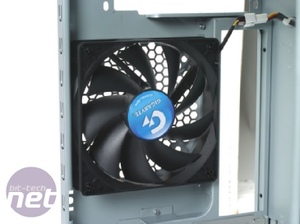
Ready, Steady, Test!
And so it comes to this, the testing. We have a strict and established testing methodology at bit-tech when it comes to reviewing cases and we follow it religiously. We always make our testing process completely open too, so if you have any questions or recommendations on how to refine the method then feel free to contact us via the forums.There are three things we look for; ease of use, thermal performance and how noisy the case is. We test each of these in that order by installing a test system in the chassis and then running various tests on it. We keep the test system the same every time too, so we know what to expect from it. You can find the specs below.
CPU: Intel Pentium XE 955 (dual-core, 3.46GHz)
Graphics Card: Sapphire Radeon X1600 XT Ultimate
Motherboard: MSI P6N SLI Platinum
RAM: 2x 512MB Corsair XMS2-667
Hard Drive: 1x 250GB Western Digital WD2500 7,200RPM
Heatsink: Asus Silent Square Pro
Now, you may be thinking that the system detailed above is a bit piddly to say the least and you’d probably be right. It’s certainly a far cry from any of the other Crysis-capable machines we use in the office. Heh. See what I did there? A Far Cry from Crysis?
However, the weaknesses of the above system are deliberate. We need a machine that generates a lot of heat but is still representative of the hardware used by the majority of PC gamers. We think that fits the bill and we’ve been using it for a long, long time to develop a comparison for all other cases we review.
Once we’ve installed the system we move onto testing the thermal performance, which we do in three areas. First, we measure the temperature of the CPU, GPU and case interior when the system is idling, i.e. only displaying the desktop. Then we run a CPU/RAM blend stress test on the system using special software which bombards the machine with complex algorithms. Finally, we use 3DMark to drive the temperature of the graphics card up.
To monitor the temperature of the various components we use ATi Tray tools, PC Alert 4 and our own digital temperature probe. We then contrast all the temperatures with the ambient.
Monitoring the noise level on the other hand is a bit more difficult and we have to be a little subjective here as, even if we did have laboratory grade equipment for monitoring the decibel output of our assembled test system then we’d still have to contend with varying background noises. In reality though, most of the good tests are the ones we monitor using human equipment anyway, so we’ll let you know if we think the volume gets out of hand.
Now, before we even started our testing we did have a few concerns about how well the Gigabyte iSolo 210 would perform – especially when it came to how easy it was to install a system in. As you can probably tell from the pictures we’ve been showing you, there isn’t a whole lot of room inside the iSolo 210, so complex tasks like attaching and removing heatsinks could potentially get a bit tricky.
Also, while the case does come with two 120mm fans installed already, it could be that that simply isn’t sufficient to cool our sweaty little ‘puter...and, now we think about it, the lack of any vibration dampening in the hard drive cage could be a problem too!
With potential problems on all fronts then, we warily approached the testing proper and couldn’t help but get a little excited at seeing how the iSolo 210 would actually perform…

MSI MPG Velox 100R Chassis Review
October 14 2021 | 15:04












Want to comment? Please log in.